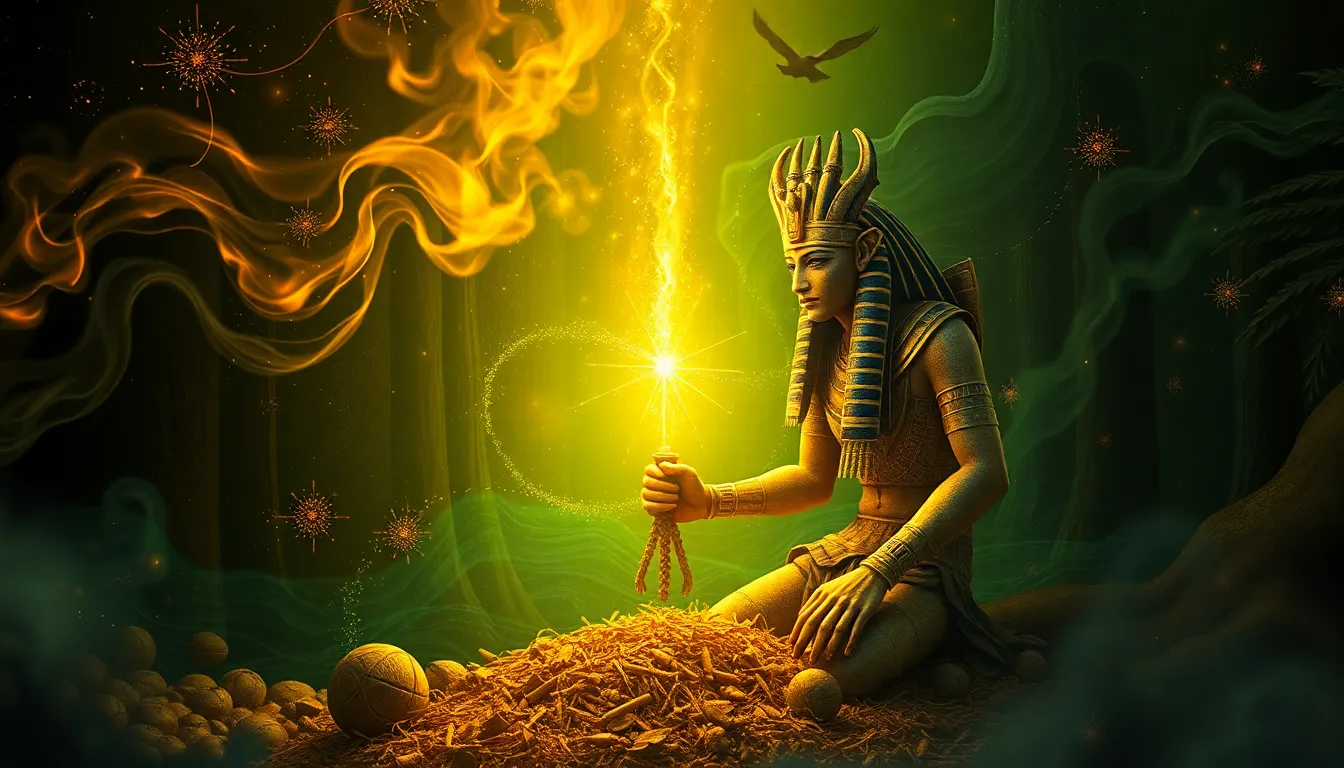The Myth of the Divine Harvest: Osiris and the Cycle of Nature
I. Introduction
Osiris is one of the most important deities in ancient Egyptian mythology, revered as the god of the afterlife, the underworld, and agriculture. His narrative is deeply interwoven with themes of fertility, death, and resurrection, reflecting the agricultural practices and beliefs of ancient Egypt. The harvest was vital to Egyptian society, providing sustenance and wealth, and the myth of Osiris offers profound insights into the connection between divine influence and the cycles of nature.
This article explores the legend of Osiris, his agricultural significance, and the enduring legacy of his myth, illustrating how these ancient beliefs continue to resonate in contemporary times.
II. The Legend of Osiris
Osiris’s origins as a deity are rich and complex. He is often depicted as a mummified king, symbolizing both the cycles of life and the inevitability of death. According to mythology, Osiris was the firstborn son of the sky goddess Nut and the earth god Geb. He was known for bringing civilization, agriculture, and the arts to humanity.
The story of Osiris is a tragic tale of jealousy and betrayal. His brother, Seth, the god of chaos and disorder, coveted Osiris’s throne. In a cunning plot, Seth killed Osiris, dismembered his body, and scattered the pieces across Egypt. Osiris’s devoted wife, Isis, searched tirelessly for his remains. With the help of her sister Nephthys and the god Anubis, she managed to reassemble Osiris, allowing him to be resurrected. This act of resurrection is symbolic of life after death and the cyclical nature of existence.
The myth of Osiris encapsulates themes of death and rebirth, emphasizing the belief that life continues beyond physical death, mirrored in the natural cycles of the agricultural year.
III. The Agricultural Significance of Osiris
Osiris is primarily viewed as the god of fertility and agriculture, symbolizing the essential relationship between the earth’s bounty and divine providence. Ancient Egyptians relied heavily on the annual flooding of the Nile River, which deposited nutrient-rich silt on the land, enabling crops to flourish.
Key aspects of Osiris’s agricultural significance include:
- Osiris as a deity of fertility, responsible for ensuring bountiful harvests.
- The Nile River, considered a sacred entity, was integral to the agricultural cycle, with its seasonal inundations directly affecting crop growth.
- Seasonal festivals and rituals, such as the Wepet-Renpet festival, celebrated the new year and the agricultural cycle, honoring Osiris with offerings and prayers for a fruitful harvest.
IV. The Cycle of Nature: Death and Rebirth
The concept of cyclical time was fundamental in ancient Egyptian cosmology. This belief system posited that life, death, and rebirth were not linear but rather a continuous cycle. Osiris’s resurrection parallels the seasonal changes experienced in nature, particularly the cycles of planting and harvesting.
Key parallels include:
- The death of Osiris represents the end of the agricultural season, while his resurrection symbolizes the rebirth of crops in spring.
- Each year, as crops were harvested, the land was seen to die, only to be reborn with the flooding of the Nile.
- Farmers would plant seeds in the hope of a bountiful harvest, reflecting the faith in Osiris’s divine intervention.
This cyclical understanding influenced agricultural practices and beliefs, emphasizing the importance of reverence for nature and its cycles.
V. Osiris and the Afterlife
The connection between harvest, death, and the afterlife is a pivotal aspect of Osiris’s mythology. After his resurrection, Osiris became the ruler of the afterlife, overseeing the judgment of souls. His role as a judge of the dead further solidified the link between agricultural fertility and spiritual rebirth.
In ancient Egyptian beliefs, the harvest was seen as a metaphor for the soul’s journey after death, with Osiris guiding the deceased through the afterlife. Key influences include:
- Osiris’s judgment of the dead was symbolized by the weighing of the heart against the feather of Ma’at, representing truth and justice.
- The rituals surrounding burial practices were designed to ensure a safe passage to the afterlife, with offerings made to Osiris to secure his favor.
- Funerary rites often included depictions of Osiris to invoke his protection and guidance for the deceased.
VI. The Cultural Legacy of Osiris
The legacy of Osiris extends beyond ancient Egypt, influencing art, literature, and religious thought throughout history. His narrative has been depicted in various forms, illustrating themes of resurrection and renewal.
Notable aspects of Osiris’s cultural legacy include:
- Osiris’s portrayal in art, often depicted as a green-skinned figure representing fertility and rebirth.
- Influence on later religions, including Christianity, where themes of resurrection and eternal life resonate with the story of Osiris.
- The enduring symbolism of Osiris in modern culture, representing the universal themes of death, rebirth, and the connection to nature.
VII. The Relevance of the Myth Today
The myth of Osiris offers valuable lessons applicable to contemporary environmental practices and our understanding of nature’s cycles. As society grapples with ecological challenges, the story of Osiris reminds us of the importance of sustainable practices and respect for the natural world.
Key points of relevance include:
- Lessons from the myth encourage sustainable agricultural practices, emphasizing the balance between human needs and environmental health.
- Understanding natural cycles fosters appreciation for seasonal changes and their impact on agriculture.
- The significance of myth provides a framework for understanding humanity’s connection to nature and the importance of preserving it for future generations.
VIII. Conclusion
Osiris plays a pivotal role in Egyptian mythology, intertwining themes of agriculture, death, and the afterlife. His narrative not only illustrates the importance of harvest in ancient Egyptian culture but also provides insights into the cyclical nature of existence.
The continuing relevance of ancient myths like that of Osiris serves as a reminder of the intertwined relationship between myth, nature, and human existence. As we face modern challenges, the lessons embedded in these stories can guide us in fostering a sustainable future.




